This is a reprint of an article appearing on QuirkyCruise.com (http://quirkycruise.com/), the world’s best guide to small ship cruising. For an unedited version please go to http://quirkycruise.com/feature-life-slow-lane-aboard-1874-built-juno-swedens-gota-canal/.
Our family trip two summers ago aboard the historic 48-passenger M/S Juno, one of Göta Canal Steamship Company‘s trio of wonderful old small cruise boats, was my first canal cruise and it won’t be my last. A great way to chill out and step off the grid for a few days, we loved moving at a snail’s pace through the beautiful Swedish countryside aboard the intimate little vessel.
Our 4-day cruise from Gothenberg on the west coast, to Stockholm on the east coast, Sweden’s two largest cities, took us through 66 step-like locks — 58 on the Göta Canal, six on the Trollhätte Canal, and a pair of locks near Stockholm. On either end of the cruise, we spent several enjoyable days in each of the historic and very walk-able cities.
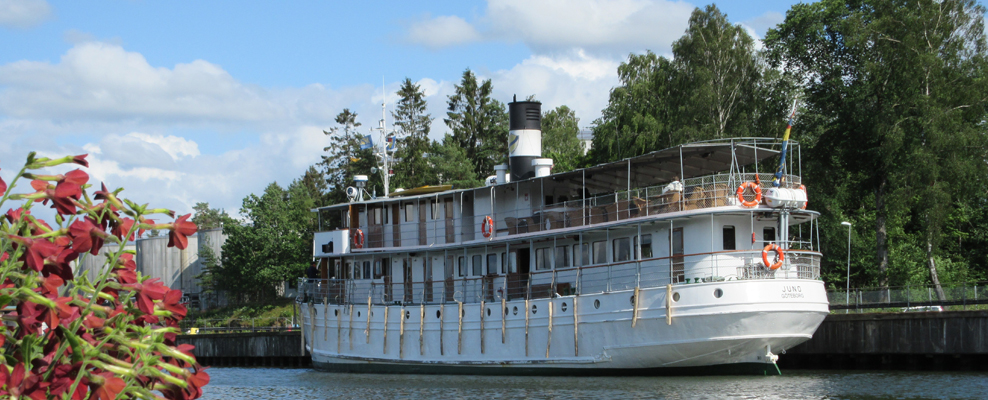
A Very Cozy Boat: My husband and twin 12-year-old sons and I occupied a pair of snug train-compartment-sized cabins at the topmost of three passenger decks. Each had bunk beds, a basin with running water above a small cupboard, and a slim closet thick enough for a few articles of hanging clothes. None of Juno’s 29 cabins have TVs or individual bathrooms, with the 48 passengers sharing seven toilets and four showers. Frankly, I had dreaded this part, but it wound up being fine. My strategy of showering after lunch worked perfectly.
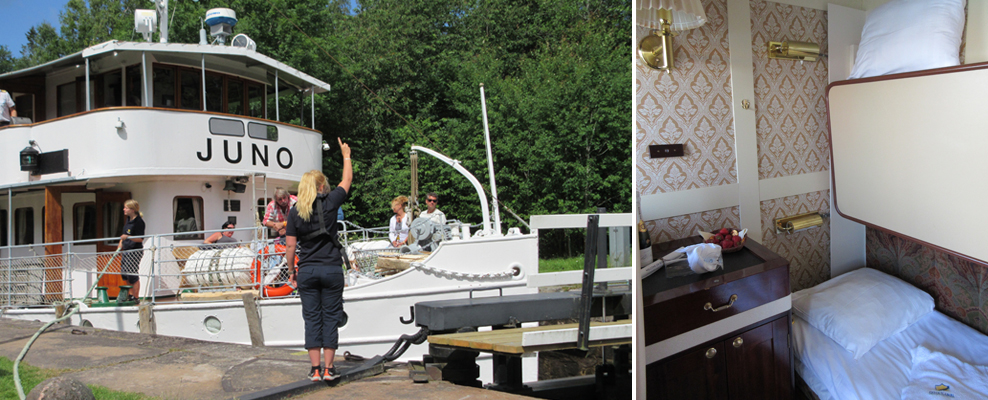
Lunches and dinners were served in a dining room (that also resembled a rail car) on elegantly set tables from a fixed menu, with dietary requests accommodated with advance notice. Highlights included delicious seafood stew and an excellent raspberry pie my family still talks about. Breakfasts were buffet-style, and the daily “fika” was a yummy teatime snack like freshly baked cinnamon buns that we looked forward to each day.
When not exploring on shore, we passed the days shuffling between the large open-air seating area at the stern of the top deck, the open bridge to chat with the captain or take a turn at the wheel, and the triangle of open deck at the bow one deck down.
Day 1: We boarded Juno in Gothenburg on a beautiful, but chilly, sunny morning, greeted at the mini gangway by our charming multi-lingual guide Katarina. Soon under way, passengers sat in sun-filled pockets of deck, wrapped in the coal-grey woolly blankets draped over all the deck chairs (temps range from the 50°F to 70°F), taking in the pastoral sites as Juno’s engines hummed and trees rustled in the wind. Puffy white clouds, cranes and seagulls cast pretty shadows on fields of undulating grain and across the rippling water. A feeling of peace and serenity would linger with us during the entire journey.
We came to our first lock after the lunch, the 8-meter-high Lilla Edet from 1916. Juno waited outside of the giant doors of the chamber until it emptied and we could enter. Meanwhile, the pair of young blond Swedish deck hands hopped off the boat to secure it by looping ropes from the boat to the bollards that line the canal system, a routine they’d repeat dozens of times over the next four days. When we moved into the chamber, the doors closed behind us, the compartment flooded and Juno was raised to the height of the next section of canal. This simple yet brilliant 19th-century technology was fascinating to see up close and especially educational for my sons.
Next were the four century-old Trollhättan locks. At the top, we docked near Trollhättan’s Canal Museum for a look around. Back on the boat, we soon passed under the first of two lift bridges, whose span rises up to allow ships to pass underneath. The crew popped champagne to toast the first day of the cruise, then the Captain brought us back down to earth. A storm was expected that night over Lake Vänern, Europe’s third largest lake, and he’d decided it was best to dock early for the night and cross it in the morning.
Day 2: When Juno resumed cruising early the next morning, it was rainy and windy as Juno (with no stabilizers) bobbed and swayed across the lake. Fewer than a dozen people made it to breakfast that morning, too queasy to eat. Luckily I had my sea legs, though my husband and sons were laid up in the cabin for an hour or two waiting it out.
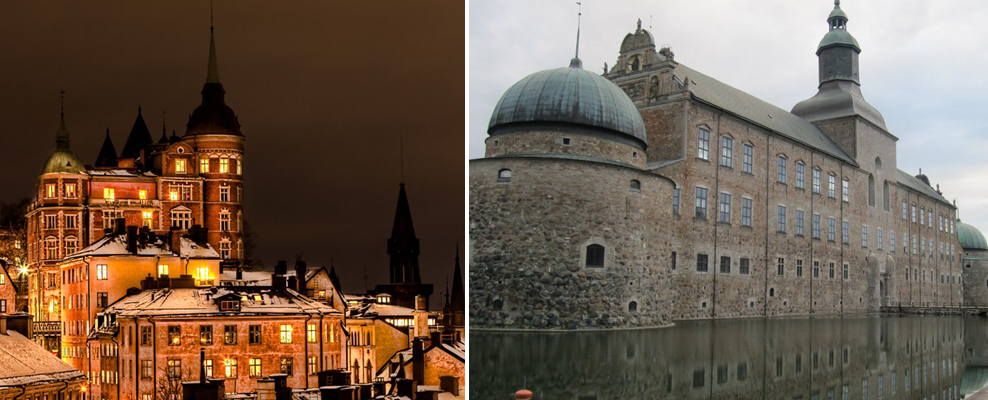
By midday, sunny skies returned and we were back in the calm waters of the canal system, though we were now behind schedule. Unfortunately we had to skip visits to 19th-century Karlsborg Castle and historic Motala. Oh well, going with the flow is part of being on a cruise. Instead, the four of us took turns riding Juno’s two bicycles (others walked) along the wild-flower lined towpath as Juno slowly moved between locks in the middle of the Swedish heartland, enjoying the fresh air and the exercise.
Dinner that evening was our favorite meal of the cruise — delicious baked pork with parsnip puree and red onion marmalade — and afterwards, we returned to the deck to admire the scenery and the gorgeous interplay of clouds and shadow in the waning sunlight of Sweden’s long summer days, as the ship inched across the country.
Day 3: We awoke to calm canal cruising, with the occasional bump as Juno’s hull grazed the bottom of the shallow canal. Sipping our morning coffee and tea, we sat on a bench on the lower deck promenade, nearly level with the shore line, and watched a flock of sheep nibbling grass a few meters away. We passed “through” small country roads, tiny bridges that were cleverly engineered to retreat into themselves (like a zoom lense) or swing open like an arm, and admired the cute doll-like wooden houses trimmed in white along the banks. At each lock was a pretty yellow cottage originally inhabited by the lock keepers and now rented to anyone willing to keep it looking spiffy for the tourists.
Before lunch the drinkers were already at their sunny perch on the foredeck, sitting next to a coil of rope and a big chunky anchor, to soak up the scenery with bottles of beer and wine from the self-service bar.
The highpoint of the day was reaching the famous Carl Johan Locks. Juno fit into each compartment like a hand in a glove. Many of us got off at the top and walked down the hill along the locks to take pictures, along with many other tourists.
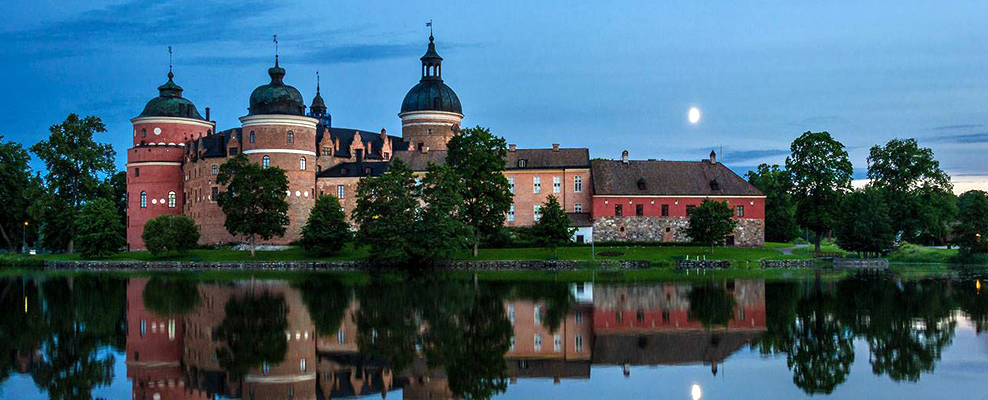
Later, we tied up in Linköping and followed Katarina on a 2-mile walk to the ruins of the 12th-century Vreta Benedictine Convent and its well-preserved Parish Church, with bright pink and red flowers planted around its gravestones. After dinner it was ice-cream cones and a stroll though the medieval town of Söderköping to admire the brightly painted wooden cottages framed by Sweden’s lovely summer flowers.
Back on board, as the day was fading into night, we once again stood at the railings and swooned over the stunning twilight sky. First Officer Robin let my sons have a turn at steering, a novelty never afforded on larger ships.
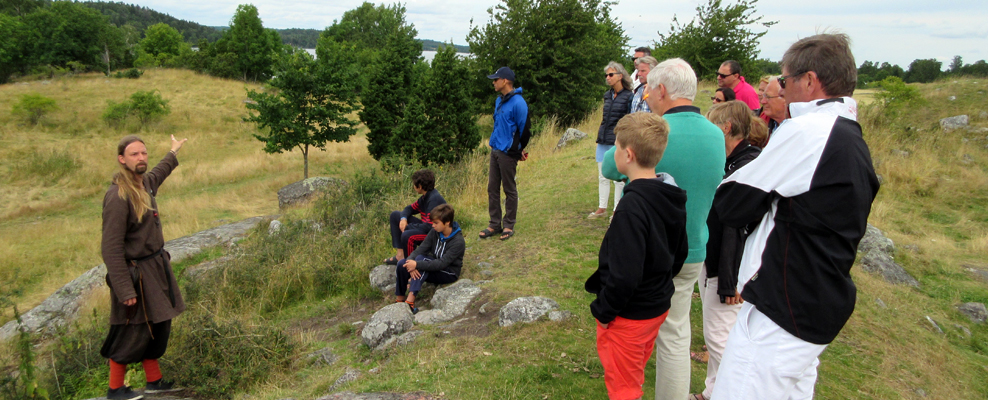
Day 4: After breakfast was a visit to Birka, one of the most important Viking sites in Scandinavia and a UNESCO World Heritage site with burial mounds dating back more than 1,000 years. Our tall archaeologist guide Andreas fit the part with long rock-band hair and a Viking’s belted tunic. He told us that being a Viking was a profession not a race — they were warriors and traders who traveled in their famous wooden ships all over Europe and also to eastern Canada and the Middle East.
After our final lunch on board, where Katarina read aloud an old poem about the building of the canal, by 4pm our quirky little Juno reached Stockholm’s 13th-century old town. Dwarfed by the huge cruise ships and ferries in the harbor, we swelled with pride to be arriving on our historic little Swedish gem.
The short Göta Canal cruise season is late May through late August. Juno cruises one way between Gothenburg and Stockholm on 4-day/3-night Classic Canal Cruises; fares include all meals and shore excursions. Two early 20th-century fleet mates, the Diana and Wilhelm Tham, offer similar 2-6 day itineraries. For more Information on the Gota Canal Steamship Company go to: http://quirkycruise.com/gota-canal-steamship-company/ [1]
Heidi Sarna is a prolific travel writer with an expertise in small-ship cruises. For a full version of the text check out her site http://quirkycruise.com/feature-life-slow-lane-aboard-1874-built-juno-swedens-gota-canal/ [2] which is an excellent resource dedicated to small ship cruises under 300 passengers and is the world’s best guide to small ship cruising.
